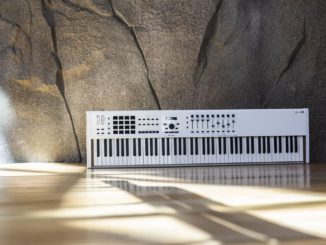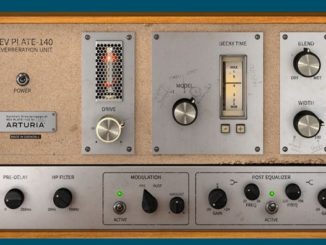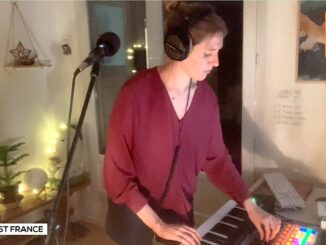Arturia Synthx V review: legendary Italian Elka Synthex multi-timbral Synthesizer authentically revived as a plugin for your DAW with advanced features beyond the original.
Arturia offers a tour du monde of software Synthesizer emulations in its current V Collection X. The majority of these synths come from the US with Moog, Oberheim, ARP, or Buchla and from Japan with Roland, Korg, or Yamaha.
Only very few legendary synths from Europe, including the MiniFreak. Two more at least will be added to the possible V Collection 11: the Minibrute V, announced after Superbooth 24, and a new one from Italy. Today, Arturia introduced the Synthx V, an emulation of the legendary Elka Synthex from 1981.
Arturia kindly provided me with a version of the plugin two weeks before the release so I could test it for you. This version was feature-completed, but the sound design was not yet finished, so I cannot give a complete overview of the included sounds of version 1.0.
Elka Synthex
On paper, Mario Maggi’s original Elka Synthex was a very analog polyphonic Synthesizer with eight voices, two digitally controlled analog oscillators, a Curtis-based multimode filter, and multi-timbral support.
It also offered two envelopes (filter, amp), two LFOs, a chorus effect, and a flexible 4-track sequencer. The original Synthex’s iconic sonic feature was its sharp, dominant sync sound, which many musicians used.
The most prominent example is the Jean Michel Jarre Laserharp sound in the Rendez Vous 3 or The Time Machine songs. Paul Wiffen programmed it, and it can be found in the synth’s factory library. Now, from the past back to the present.
Arturia Synthx V
Synthx V is an emulation of the Elka Synthex from 1981 and offers two layers, each with an independent sound. As with any emulation, Arturia splits the plugin into two sections.
One is authentic and recreates the original Synthex feature set. At the same time, the second is the advanced section, which incorporates ideas from the new, modern age, such as a multi-FX processor.
I must highlight that I cannot say how close or exact the emulation is to the original. I don’t have an Elka Synthex in my mini studio or have had much time to work with one. But I’m open to purchasing if you have 11000€ (Reverb) to give away.
In addition, analog emulations are usually based on one or two devices, and each slightly varies in how they behave and sound. Let’s start with the oscillators.
Oscillators
Like the original, the Arturia Elka Synthex plugin has two oscillators with selectable triangle, square, and pulse waveforms. Each oscillator has controls for the octave (1′ – 16′), transpose (12-12), pulse width, and volume. Unlike in the Syn’X2 by Xils Lab, you can’t use multiple waveforms in an oscillator.
The pulse-width cross-modulation (OSC1 PWM/OSC2 PWM) on both oscillators is a highlight of the Synthex and is also available in Arturia’s soft replica.
If you activate both simultaneously, you get a lovely, waveform-wavy sound. Detune both, and it changes drastically to a rich, harmonic, beefy sound reminiscent of a ring mod-style sound. Of course, ring mod is also onboard for both oscillators.
Hard sync is also necessary in this emulation. Turn on both oscillators, set different oscillator octaves, select the hard sync setting, and modulate the transpose. The result is those Jarre-like sharp sync sounds you know from the Elka Synthex.
If the oscillators are not authentic enough for you, you can dial in the oscillator’s dispersion in a virtual hidden service panel. Next to the oscillators, you also have a noise generator with white and pink flavors for a more noisy affair.
A glide/portamento function is also routable to oscillators 1 or 2 and both. Unlike the original, Synthx V includes a unison mode, which melts five voices into one juicy note. It’s delightful with the hard sync and ring mod on.
Filters
From there, the oscillators and noise move into a multimode filter. The original Elka Synthex from 1981 used a Curtis-based CEM3320-based multimode. In a time when you often only got lowpass, this 4-pole configuration went much further than any of the American or Japanese polysynths.
In Arturia Synthx V, you can work with all those filters: 1-pole lowpass, 2-pole lowpass, 1-pole bandpass, 2-pole bandpass, and highpass, selectable with buttons. You can tweak them with classic cutoff and resonance and apply keyboard tracking and modulation.
Many vintage experts reported that the original was very musical, especially at high resonances due to its unique multi-topology. I think the Synthx V reflects this very well. It does not go into extreme self-oscillation at high resonance levels but instead colors the sound beautifully.
Self-oscillation only becomes super audible when used to its maximum (9-10). Others must judge how exactly the sound and behavior compare to the original. I like how it colorizes the sound.
Modulation
On the modulation side, the Synthx V offers the original features with a multi-wave layer LFO and two envelopes. The LFO ships with various waveforms, modulation targets, and controls, including frequency, delay, and two times depth.
Yes, they are pretty basic modulators, but the delay on the LFO is very handy, as you can vary the modulation when it happens in the sound. The envelopes are classic ADSR envelopes with added velocity control. It’s a pity they are fixed to the filter/amp, and you can’t route them to other parameters.
Don’t worry—there is an advanced section with more modulation options. I will showcase this in more detail in another section of the article. Under the envelopes, you can also find a pan/volume control with spread control.
Next to this is an emulation of the original analog BBD-based chorus unit, which was an essential part of the Elka Synthex hardware. This is a crucial synth feature for many, making the oscillator so fat and beautiful.
I turned it on and off in patches. It didn’t massively turn the oscillators on the head. It’s a classic, lush chorus that widens and adds juice to the sound, especially in levels 2 and 3. In terms of sound quality, it’s a very good one, but I can’t say how close it is to the OG.
Before the virtual keyboard starts, you will find a master LFO with frequency control layer routing options and various targets. Alternatively, it’s possible to control it with the mod wheel and sync it.
In the middle of the lower section, Synthx V hosts the layer control giving you full access over the layers, the hidden panel for fine-tuning the oscillators/filters, and a master section. The latter includes a hold function, a vintage knob that adds the voice/filter/VCA fluctuations of vintage synths, and a master tuning.
By clicking on the advanced button, you can expand the Arturia Synthx V with new features that were technically impossible in the Elka Synthex in 1981.
Arturia Synthx Goes Behind The Original Elka Synthex
The advanced section comprises five sections: a multi-arpeggiator, a multi-FX processor, a three-slot function generator, keyboard mappings, and the macro page.
Let’s start with the four-track arpeggiator, loosely inspired by the original four-track sequencer of the Elka Synthex. For its time (1981), it was a very sophisticated, mature sequencer with many possibilities. In Synthx V, the Arturia developers created a new four-track arpeggiator with an inspiring engine.
Each arpeggiator track builds on three elements: the arpeggiator, a rhythm section, and the gate. The arpeggiator section offers many built-in melodic patterns beyond the classic up, down, up down… settings. You can transpose and set each pattern’s octave and start offset.
In the rhythm section, you can modify the pattern length from 1 up to 16 steps and use an additional retrigger option. Patterns can also be saved. The gate can be customized with note repeat, velocity, and randomization in the dedicated note module.
A multi-arp preset can save all four arpeggiators with their individual pattern settings. However, it’s a shame that you can’t save individual arpeggiators.
Further, the rate and gate of the multi-arp patch are tweakable and sync-able, and you can set a proper scale for it. A very fun multi-arp where you don’t miss the sequencer from the original. And it’s also controllable from the front panel.
Multi-FX
Like the other Arturia V Collection instruments, the new Synthx V offers a comprehensive multi-FX processor that can be used alongside the original flavored chorus.
Four slots can be loaded with various algorithms, including reverb, delay, tape echo, multiband compressor, distortions, Juno chorus, flanger…
Each effect is extensively tweakable, has presets, and can also be modulated. I don’t like to repeat myself about the sounds, but they are on the same high level as in the other V plugins.
Powerful Modulation
In addition, it hosts a well-known and valued modulation engine. It has three slots, each of which you can load a flexible, fully customizable modulator: an ADSR envelope, function generator, random generator, and sequencer.
This has been proven in many other Arturia plugins and works without problems. You can map parameters in a few clicks using simple drag-and-drop.
Compared to the original envelope and LFO setup, these three slots supercharge the Synthex sound with an impressive sound design potential. They open the door for evolving patches to super experimental sounds unimaginable with Mario Maggi’s 1981 Elka Synthex.
Besides this, Arturia Synthx V also supports expressive control via mod wheel, keyboard tracking, velocity, release velocity, aftertouch, and MPE mappings. Here, too, it is an easy task with drag and drop.
For example, you could craft those laser harp sync sounds with MPE in a super-expressive way instead of classic envelope modulation.
MPE & More
The fifth and last section is dedicated to four customizable macro controls with one or more assignable parameters. It is a great way to archive multiple sounds from a single preset with a twist on the macro controls and proper settings.
Last but not least, Synthx has various play options. Monophonic, polyphonic, or bi-timbral, with eight voices and four on each layer or 16 voices and eight on each layer.
The plugin comes with 240 presets from professional sound designers, such as in-house designer Lil Jordy or Diego Tejeida (ex-Haken, now TEMIC). Only 41 sounds out of 240 were available in the press test version. These already covered a wide range from classic up to more unusual ones.
Sound Demo
Arturia Synthx V Review
All in all, the new Synthx V is another very high-quality Synthesizer plugin for the V Collection world. It sounds big, very rich and beautiful. For me, it is very Synthex-like. I cannot judge, however, how close the plugin is to the Elka Synthex because I don’t have the vintage synth, and YouTube demos only give an inaccurate picture of it. Only the in-person comparison is important here.
The new features added to the Elka Synthex emulation are well-known but fit well with the package. A downer is the relatively high CPU usage, as with other Arturia plugins
Pro
- sound quality
- feature set
- advanced feature set levels up the emulation
- fun multi-track arpeggiator
- MPE support
Neutral
- filter/amp envelopes don’t have custom mappings
- no waveform mix for the oscillators
- 100% authentic yes/no?
Contra
- high CPU consumption
- pricey
Alternatives: Cherry Audio ELKA-X or Xils Lab SYN’X or miniSyn’X
Arturia Synthx V is available now for 199€. f. Existing Arturia customers get a special price by logging in to their user accounts. It runs as a VST, VST3, AU, and AAX plugin on macOS (native Apple Silicon + Intel) and Windows.
More information here: Arturia
Available at my partner














A couple of friendly corrections: the Synclavier, by New England Digital of Norwich, Vermont, USA is very much an American instrument. Also,’Mario’ Maggi is the designer of the Elka Synthex, as well as the Generalmusic S2/S3. Re Arturia’s offering, the Synthex has already been recreated quite well by both XILS-Lab and Cherry Audio – it will be interesting to see how this compares to those?
thanks!
I would be very curious to hear how well it does Jarre’s Laser Harp sound. None of the VST emulations have been able to deliver it properly so far (dare I say even my AN1x patch is closer than they are!)
By the way – the sound on JMJ’s “Time Machine” track is not the Synthex. It’s actually done on a Virus (same goes for Oxygene 14, which also features it)
well it shows that you don’t need that super 100% perfect Synthex for it 😉 but I read in an article:
‘Electronica 1: The Time Machine’ uses the following electronic instruments: ARP 2600, EMS AKS, EMS VCS3, Fairlight CMI, Minimoog, Memorymoog, Moog Modular 55, RMI Harmonic, Roland Jupiter 8, Korg Micro-Preset, Theremin, Korg MS20, Roland AXS, GRP Modular, Elka Synthex,..
The Virus emulation (funnily enough, was created by a JMJ fan, Per Kristian Risvik approx 20 years ago) is not exactly perfect – it’s quite thin sounding and there’s no movement when the sync envelope ends
perkristian.net/sounds/viruskb_laserharp.mp3
I did a better sounding patch on Yamaha AN1x – jote.eu/musique/an1x/s3.mp3
Anyway I consider Laser Harp sound to be a very good test of the Synthex emulation accuracy, because it relies on sync (which is tricky on non-saw waves), PWM and chorus to deliver that huge sound.
I’m not sure where that information about Synthex on Time Machine comes from (and it doesn’t explicitly say it was used for the Laser Harp sound). Even if it comes from an official source it’s not true – it sounds exactly like that Virus patch. I also had it confirmed by his production assistant.
Here below a demonstration, Elka Synthex,
Minute 1, 29 seconds … about Laser Harp.
https://www.youtube.com/watch?v=1oXXmaH2Ghs
Thanks for the article. Synthex is astounding!